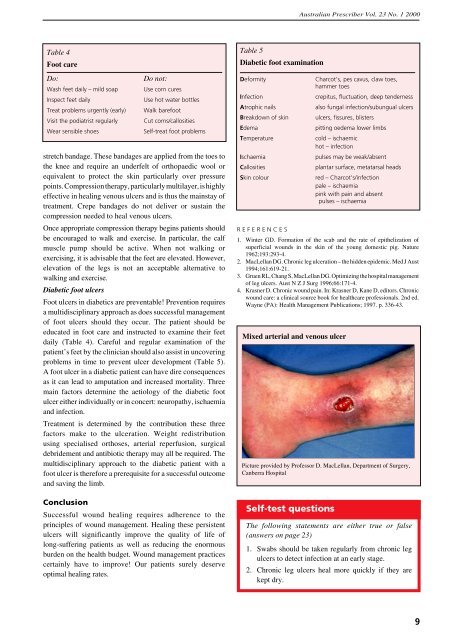PDF version - Australian Prescriber
PDF version - Australian Prescriber
PDF version - Australian Prescriber
You also want an ePaper? Increase the reach of your titles
YUMPU automatically turns print PDFs into web optimized ePapers that Google loves.
<strong>Australian</strong> <strong>Prescriber</strong> Vol. 23 No. 1 2000<br />
Table 4<br />
Foot care<br />
Do:<br />
Wash feet daily – mild soap<br />
Inspect feet daily<br />
Treat problems urgently (early)<br />
Visit the podiatrist regularly<br />
Wear sensible shoes<br />
Do not:<br />
Use corn cures<br />
Use hot water bottles<br />
Walk barefoot<br />
Cut corns/callosities<br />
Self-treat foot problems<br />
stretch bandage. These bandages are applied from the toes to<br />
the knee and require an underfelt of orthopaedic wool or<br />
equivalent to protect the skin particularly over pressure<br />
points. Compression therapy, particularly multilayer, is highly<br />
effective in healing venous ulcers and is thus the mainstay of<br />
treatment. Crepe bandages do not deliver or sustain the<br />
compression needed to heal venous ulcers.<br />
Once appropriate compression therapy begins patients should<br />
be encouraged to walk and exercise. In particular, the calf<br />
muscle pump should be active. When not walking or<br />
exercising, it is advisable that the feet are elevated. However,<br />
elevation of the legs is not an acceptable alternative to<br />
walking and exercise.<br />
Diabetic foot ulcers<br />
Foot ulcers in diabetics are preventable! Prevention requires<br />
a multidisciplinary approach as does successful management<br />
of foot ulcers should they occur. The patient should be<br />
educated in foot care and instructed to examine their feet<br />
daily (Table 4). Careful and regular examination of the<br />
patient’s feet by the clinician should also assist in uncovering<br />
problems in time to prevent ulcer development (Table 5).<br />
A foot ulcer in a diabetic patient can have dire consequences<br />
as it can lead to amputation and increased mortality. Three<br />
main factors determine the aetiology of the diabetic foot<br />
ulcer either individually or in concert: neuropathy, ischaemia<br />
and infection.<br />
Treatment is determined by the contribution these three<br />
factors make to the ulceration. Weight redistribution<br />
using specialised orthoses, arterial reperfusion, surgical<br />
debridement and antibiotic therapy may all be required. The<br />
multidisciplinary approach to the diabetic patient with a<br />
foot ulcer is therefore a prerequisite for a successful outcome<br />
and saving the limb.<br />
Conclusion<br />
Successful wound healing requires adherence to the<br />
principles of wound management. Healing these persistent<br />
ulcers will significantly improve the quality of life of<br />
long-suffering patients as well as reducing the enormous<br />
burden on the health budget. Wound management practices<br />
certainly have to improve! Our patients surely deserve<br />
optimal healing rates.<br />
Table 5<br />
Diabetic foot examination<br />
Deformity<br />
Infection<br />
Atrophic nails<br />
Breakdown of skin<br />
Edema<br />
Temperature<br />
Ischaemia<br />
Callosities<br />
Skin colour<br />
Self-test questions<br />
Charcot’s, pes cavus, claw toes,<br />
hammer toes<br />
crepitus, fluctuation, deep tenderness<br />
also fungal infection/subungual ulcers<br />
ulcers, fissures, blisters<br />
pitting oedema lower limbs<br />
cold – ischaemic<br />
hot – infection<br />
pulses may be weak/absent<br />
plantar surface, metatarsal heads<br />
red – Charcot’s/infection<br />
pale – ischaemia<br />
pink with pain and absent<br />
pulses – ischaemia<br />
R E F E R E N C E S<br />
1. Winter GD. Formation of the scab and the rate of epithelization of<br />
superficial wounds in the skin of the young domestic pig. Nature<br />
1962;193:293-4.<br />
2. MacLellan DG. Chronic leg ulceration – the hidden epidemic. Med J Aust<br />
1994;161:619-21.<br />
3. Gruen RL, Chang S, MacLellan DG. Optimizing the hospital management<br />
of leg ulcers. Aust N Z J Surg 1996;66:171-4.<br />
4. Krasner D. Chronic wound pain. In: Krasner D, Kane D, editors. Chronic<br />
wound care: a clinical source book for healthcare professionals. 2nd ed.<br />
Wayne (PA): Health Management Publications; 1997. p. 336-43.<br />
Mixed arterial and venous ulcer<br />
Picture provided by Professor D. MacLellan, Department of Surgery,<br />
Canberra Hospital<br />
The following statements are either true or false<br />
(answers on page 23)<br />
1. Swabs should be taken regularly from chronic leg<br />
ulcers to detect infection at an early stage.<br />
2. Chronic leg ulcers heal more quickly if they are<br />
kept dry.<br />
9
















